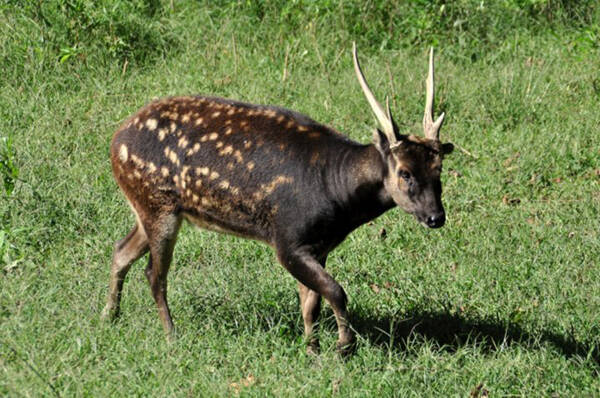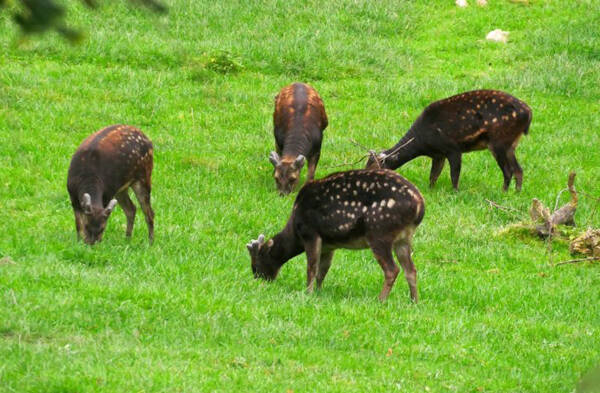Rusa alfredi
IUCN
LCBasic Information
Scientific classification
- name:Rusa alfredi
- Scientific Name:Rusa alfredi,Philippine Spotted Deer,Prince Alfred’s Spotted Deer,Visayan Spotted Deer,Prinz-Alfred-Hirsch,Philippine sika deer, Visayan sambar deer, Visayan spotted deer, Visayan sika deer, Acheron&#
- Outline:Ungulata
- Family:Artiodactyla Cervidae Sambar
Vital signs
- length:About 128 cm
- Weight:40-60kg
- lifetime:No verification information
Feature
One of the rarest, least known and most narrowly distributed deer species in the world
Distribution and Habitat
The Philippine Sambar is found in the Visayas in the central Philippines. It is found in only three or four remaining forests on Panay and Negros. It is one of the rarest, least known, and narrowly distributed deer species in the world. The species was once found throughout the Visayan islands of Panay, Negros, Cebu, Guimaras, Leyte, and Samar.
Philippine Sambar was once most common in the densely populated interior of the Visayas. They were abundant from sea level to mountaintops throughout the islands. The interior of the islands consists of dense, rugged tropical forests ranging from 750-1,000 meters above sea level. The mountains are washed by a series of short, violent streams. Philippine Sambar prefers areas that have experienced natural disturbances such as fires or landslides. Wildfires burn open the canopy of sheltering trees, allowing tender plants close to the ground to grow.
Appearance
The Philippine sambar deer is a small, short-legged, crouching deer, with an adult head-to-body length of 128 cm, a shoulder height of 64-77 cm, and a tail length of 9-12 cm. Females are much smaller than males. The ears and tail are relatively short. The upper body has a fine, dense, soft coat. The overall coat color is dark brown, sometimes with red highlights, but the sides are covered with a small number of white or light yellow spots, which are largest on the rump and gradually become smaller and darker towards the shoulders (when the coat becomes pure brown). These spots do not fade and remain throughout life. The underside and inner surface of the legs are white, and the underside of the short tail is white. The head is relatively pointed. The head is usually paler than the body, but the forehead and muzzle are usually black. Males grow short antlers about 25 cm long, each with 3 sharp teeth.
Details
Philippine sambar deer (scientific name: Rusa alfredi) English Philippine Spotted Deer, Prince Alfred’s Spotted Deer, Visayan Spotted Deer, German Prinz-Alfred-Hirsch, no subspecies.

Philippine Sambar Long overlooked as an obscure and poorly known regional variant of the widely distributed sambar deer (Rusa unicolor), Rusa alfredi was not formally recognized as a separate, endemic, and highly distinct species until 1983. Subsequent reviews of the systematic relationships and phylogeny of Southeast Asian deer by Meijaard and Groves in 2004 and Pitra et al. Resulting in the transfer of the species from the genus Cervus to the genus Sambar. Populations from Panay and Negros have not been studied for taxonomic differences, but they have been separated for thousands of years and are currently managed separately.
Philippine sambar deer are herbivorous animals, gathering in small herds of up to 3 deer as family units, and this small herd size may be the result of human disturbance. Males may be solitary. They are usually nocturnal and are very cautious when they emerge from the forest to forage in open areas, retreating into dense forest when disturbed. During the rutting season males will "roar" to challenge other males and possibly to attract females; the sound sounds very much like the barking of dogs heard from a distance.
Philippine sambar deer are herbivores, and their diet consists of a variety of plants, tender grasses, low-growing leaves and shoots. The species prefers succulent vegetation that emerges after fires, landslides, and other natural disasters.

The mating system of the Philippine sambar is not well understood, but it is likely to be similar to that of other sambar deer, with males competing to get close to females in heat. Competitions often involve sparring and bellowing. The successful males are usually older and larger, and are able to drive off younger, smaller males, and are the ones that mate with the females. The breeding season occurs in November-December. The breeding season is followed by a gestation period of 240 days, with fawns born in May-June of the following year. In fact, births have been recorded in the wild in March, May, and June, but fawns can be seen in all seasons. In captivity, fawns can be born year-round. Fawns begin to grow antlers after their first birthday.
As of 2015, the Philippine Sambar Deer is listed as an endangered species because its population size is estimated to be less than 2,500 mature individuals, the number of mature individuals is estimated to continue to decline, and no subpopulation may contain more than 250 mature individuals. Its home area, based on the maximum extent of habitat that may be occupied, is estimated to be about 1,100 square kilometers.
A 1991 survey found that the Philippine Sambar deer has been found to have been found in over 95% of its range. Due to the collapse of the sugar and logging industries, landless farmers and families have been forced into the forests, clearing them at an extremely painful rate. The lands where the species once roamed are now used for farming and then abandoned, resulting in the need to clear more forests. Abandoned farmlands are slow to regenerate secondary forests due to a lack of available nutrients in the soil. The main natural enemy is humans. Farmers and other unemployed locals living in the surrounding forests make hunting a living. The Philippine Sambar deer is a protected species, but the remoteness of its habitat makes it very difficult for guards to patrol. This has put increasing pressure on the small remaining populations. Hunting pressure is greatest during the dry season from January to June each year.
Listed on the IUCN Red List of Threatened Species (IUCN) 2016 ver3.1 - Endangered (EN).
Protect wild animals and stop eating game.
Maintaining ecological balance is everyone's responsibility!








